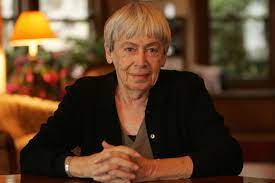Biography of TSALI in Short

Biography of TSALI TU YOU YOU URSULA K. LE GUIN
In May 1838, Tsali’s brother came to his cabin with urgent news. The white men from across the ocean were rounding up native Cherokee people and driving them off their land Before the next new moon, all Cherokee must begin the long march west. If they refused, they could be killed.
Up until then, Tsali had lived a quiet life in a cabin by the Nantahala River, with his wife and three sons. He didn’t see why he ought to move.
As soldiers scoured the land, thousands were forced out of their homes. Some managed to evade capture but Tsali wasn’t so lucky. When the soldiers came across his house, they led him and his family away.
While they were travelling, Tsali’s wife stumbled and one of the soldiers jabbed her with his bayonet. This made Tsali furious, In their own language, he told his people: When we reach the next turn, I shall pretend to have hurt my ankle. As the soldiers stop, leap on them and seize their guns. Then we shall escape to the mountains.
The plan worked, though one soldier was accidentally killed in the tussle. Tsali and his family fled and found refuge in a cave on the side of a mountain. There, they lived among other Cherokee who had been driven into hiding, making a vow never to abandon their homeland.
The army generals were humiliated One of their own men had been killed. Their general proposed that if Tsali turned himself in, they would move on without hunting down the three hundred other Cherokee hiding in the Smoky Mountains.
Tsali gave himself up in exchange for the freedom of his people.
Itis sweet to die in one’s native land Tsali said, while waiting to be shot. and to be buried by the margins of one’s native stream.
Over a hundred years later, the land was flooded, and Tsali’s grave now lies beneath Fontana Lake. The three hundred Cherokee he saved became the ancestors of over five thousand Native Americans alive today.
Biography of TSALI TU YOU YOU URSULA K. LE GUIN
Biography of TU YOU YOU in Short

(BORN 1930)
In the 1960s, North Vietnam was in the midst of a chaotic war with the South. It wasn’t only bullets and bombs the troops had to worry about. For soldiers picking their way through the deep rainforest, malaria was a far more pressing concern Being bitten by a mosquito and contracting the disease would mean a high fever, vomiting, yellow skin, and quite possibly death.
Medicine existed but it was no longer working and scientists everywhere were trying and failing to find a cure Desperate, the leader of North Vietnam went to the president of China and asked for his help. In response, a secret initiative called Project 523 was established. That was where Tu came in.
Tu had been inspired to go into medicine ever since contracting tuberculosis as a child. The experience made her want to understand disease so that she could keep herself healthy and help others too. At university, she studied not just modern medicine, but traditional Chinese herbal medicine too, believing that there was a lot to be learned from 2,500 years of history.
It was this experience of traditional medicine that Tu brought to Project 523. Scientists across the world had tested over 240,000 different compounds and none had worked. Under Tu’s guidance, two hundred traditional Chinese recipes were concocted instead and tested on mice.
A small, spiky plant called sweet wormwood appeared to be effective on animals. Not wanting to endanger anyone else’s life, Tu tested the treatment on herself first. It worked, completely eradicating her symptoms of tuberculosis
Thanks to Tu’s research, millions of lives were saved all across the developing world. In 2015, she was awarded the Nobel Prize. Many people saw it as a victory for traditional Chinese medicine, and proof that we still have a lot to learn from our ancestors.
Biography of TSALI TU YOU YOU URSULA K. LE GUIN
Biography of URSULA K. LE GUIN in Short

(1929-2018)
Ursula’s parents were anthropologists, which meant they studied people from all around the world, and looked at what makes us human and what bonds us together. Her mother chronicled the last of the Yani people, a tribe of Native Americans who had once roamed the Sierra Nevada mountains. She was interested in how they had lived before colonists arrived from across the ocean and slaughtered them in order to take control of their lands.
The house was always full of books and Ursula began reading and writing at a young age. She sent off her first story when she was eleven, to a magazine called Astounding Science Fiction. It was rejected. As were all her stories for years to come. But she never gave up. It took ten years for a publisher to finally take notice.
When Ursula married and had children, her husband took over a lot of the housework and family duties so she had more time to write. She used the time to create Earthsea: a vast world made up of hundreds of islands, surrounded by uncharted expanses of ocean. In her stories, wizards wrestle weather, ancient dragons llatten settlements, and everything hangs in a delicate balance between land and sea, light and dark, and good and evil.
Once it was published, generations of children spent hours escaping to Earthsea, following the adventures of Sparrowhawk, a young wizard who left the peaceful island of Gont to study magic across the ocean.
In another book, Ursula created a race of people called Gethenians, who existed without gender. She wanted to explore how characters acted when they weren’t expected to be boys or girls.
Using a different set of tools, Ursula explored the same deep questions her parents had. How should we be in the world? Are there other ways to live? What is fair?
When Ursula died in early 2018, people all over the planet stood up to thank her for the magic and wisdom she’d given to their lives.